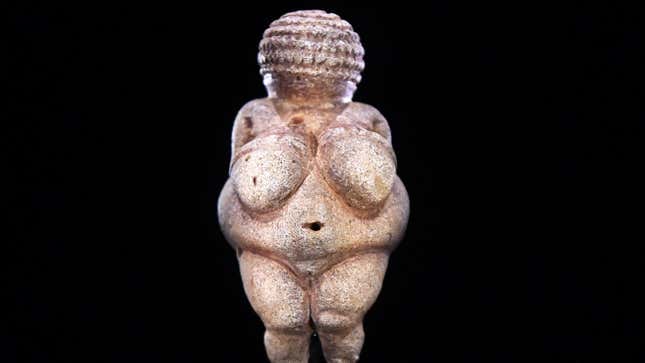Sorry to Jean Auel, My Queen
In Depth

Fans of Jean Auel’s Earth’s Children series (me) and Jean Auel herself will likely be devastated to learn that there’s a new theory floating out there about the purpose of those Paleolithic statues of shapely, big-breasted women—they may be less about fucking and honoring the Great Earth Mother, and more related to… surviving climate change. Damn.
In a study published in the journal Obesity, the three authors “analyzed Paleolithic figurines of women with obesity”—i.e., scrutinized their bodies and measured waist-to-hip ratios—and found that “figurines are less obese as distance from the glaciers increases.” They concluded, “Because survival required sufficient nutrition for child‐bearing women, we hypothesize that the overnourished woman became an ideal symbol of survival and beauty during episodes of starvation and climate change in Paleolithic Europe” and became, as they put it, “an ideological tool to help improve fertility and survival of the mother and newborns.” In other words, these so-called Venus figurines represent in part yet another impossible beauty standard. Imagine how many aurochs you’d have to kill by digging a pit, driving them into the pit, and then spearing them to death to achieve this ideal, and during an Ice Age to boot!
In what I can only surmise is a dig aimed squarely at Auel, the authors wrote, somewhat contradicting themselves, that “current thinking is that they may have represented beauty or fertility figures, but there is little supporting evidence.” As a rebuttal, I would like to point out that actually there is quite a lot of supporting evidence—and that evidence is Jean Auel’s Earth’s Children series. (The lead author of the study, I should note, is not an anthropologist–he’s a physician and professor that “specializ[es] in renal disease and hypertension.”)
Still, the idea that cooling temperatures influenced the look of these Venus figurines is intriguing enough that William Haviland, professor emeritus at the University of Vermont’s anthropology department, thinks there could be something to it. “At least they are based on real data, rather than pure speculation,” Haviland said to CNN. The shade to my queen Jean Auel!